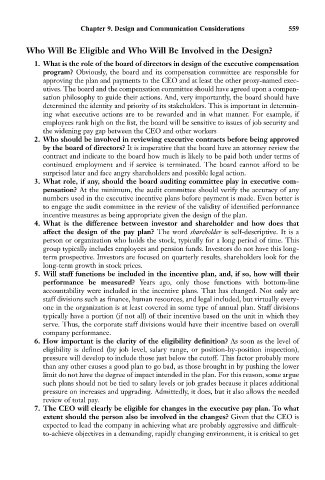Page 573 - Bruce Ellig - The Complete Guide to Executive Compensation (2007)
P. 573
Chapter 9. Design and Communication Considerations 559
Who Will Be Eligible and Who Will Be Involved in the Design?
1. What is the role of the board of directors in design of the executive compensation
program? Obviously, the board and its compensation committee are responsible for
approving the plan and payments to the CEO and at least the other proxy-named exec-
utives. The board and the compensation committee should have agreed upon a compen-
sation philosophy to guide their actions. And, very importantly, the board should have
determined the identity and priority of its stakeholders. This is important in determin-
ing what executive actions are to be rewarded and in what manner. For example, if
employees rank high on the list, the board will be sensitive to issues of job security and
the widening pay gap between the CEO and other workers
2. Who should be involved in reviewing executive contracts before being approved
by the board of directors? It is imperative that the board have an attorney review the
contract and indicate to the board how much is likely to be paid both under terms of
continued employment and if service is terminated. The board cannot afford to be
surprised later and face angry shareholders and possible legal action.
3. What role, if any, should the board auditing committee play in executive com-
pensation? At the minimum, the audit committee should verify the accuracy of any
numbers used in the executive incentive plans before payment is made. Even better is
to engage the audit committee in the review of the validity of identified performance
incentive measures as being appropriate given the design of the plan.
4. What is the difference between investor and shareholder and how does that
affect the design of the pay plan? The word shareholder is self-descriptive. It is a
person or organization who holds the stock, typically for a long period of time. This
group typically includes employees and pension funds. Investors do not have this long-
term prospective. Investors are focused on quarterly results, shareholders look for the
long-term growth in stock prices.
5. Will staff functions be included in the incentive plan, and, if so, how will their
performance be measured? Years ago, only those functions with bottom-line
accountability were included in the incentive plans. That has changed. Not only are
staff divisions such as finance, human resources, and legal included, but virtually every-
one in the organization is at least covered in some type of annual plan. Staff divisions
typically have a portion (if not all) of their incentive based on the unit in which they
serve. Thus, the corporate staff divisions would have their incentive based on overall
company performance.
6. How important is the clarity of the eligibility definition? As soon as the level of
eligibility is defined (by job level, salary range, or position-by-position inspection),
pressure will develop to include those just below the cutoff. This factor probably more
than any other causes a good plan to go bad, as those brought in by pushing the lower
limit do not have the degree of impact intended in the plan. For this reason, some argue
such plans should not be tied to salary levels or job grades because it places additional
pressure on increases and upgrading. Admittedly, it does, but it also allows the needed
review of total pay.
7. The CEO will clearly be eligible for changes in the executive pay plan. To what
extent should the person also be involved in the changes? Given that the CEO is
expected to lead the company in achieving what are probably aggressive and difficult-
to-achieve objectives in a demanding, rapidly changing environment, it is critical to get

